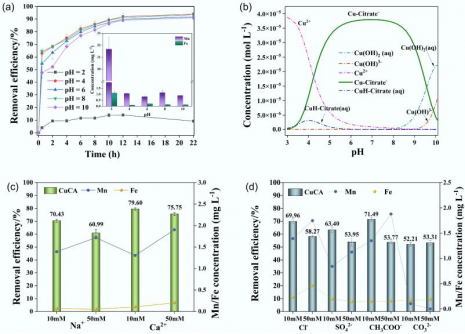Science
Innovative Biochar Material Achieves 99.5% Copper Removal from Water

A groundbreaking study has unveiled a new method for removing persistent metal complexes from water, achieving a remarkable 99.5% copper removal rate. Researchers from Beihang University, led by Wenhong Fan, developed a ferromanganese oxide-modified biochar (FMBC-600) that efficiently targets stable metal-organic pollutants, particularly copper-citrate complexes prevalent in industrial wastewater.
The research, published in Biochar X on 14 October 2025, addresses the growing challenge of freshwater scarcity and the ineffectiveness of traditional wastewater treatment methods. These conventional techniques primarily focus on free metal ions, often neglecting the more complex metal-organic compounds that are resistant to degradation and pose significant ecological and health risks.
Copper-citrate complexes, commonly found in sectors such as electroplating and textile dyeing, require innovative solutions due to their stability and migration potential. The study’s authors note that while biochar has emerged as a promising, low-cost adsorbent, its effectiveness has been limited by insufficient active sites and selectivity.
In response to these limitations, the researchers synthesized FMBC-600 through impregnation and high-temperature calcination. Characterization of the modified biochar revealed a significant transformation in its surface structure, with scanning electron microscopy (FE-SEM) showing a rough surface coated with nanoparticles sized between 80 and 100 nanometers. This structural change enhances its adsorption capabilities.
The study analyzed various aspects of the material’s performance, including its ability to remove CuCA complexes from water. The results indicated that under optimal conditions—specifically an iron-to-manganese ratio of 1:4, manganese concentration of 0.03 M, and pyrolysis temperature of 600 °C—the FMBC-600 achieved a 92.6% reduction in total organic carbon. Notably, adsorption occurred rapidly within 30 minutes, maintaining high efficiency across a pH range of 4–10.
Even in the presence of competing ions like Na+, Ca2+, Cl−, and SO42−, FMBC-600 demonstrated strong selectivity and resistance to interference, underscoring its potential for real-world applications. Kinetic modeling suggested that the adsorption process is dominated by chemisorption, as indicated by a fit to a pseudo-second-order equation (R2 > 0.99).
The researchers also conducted regeneration tests, revealing that FMBC-600 retained approximately 80% of its efficiency after two cycles. This durability, alongside its excellent stability and reusability, positions FMBC-600 as a scalable and effective solution for removing heavy metal complexes from wastewater.
The implications of this research extend beyond wastewater treatment. The technology’s simple and low-cost production process makes it suitable for large-scale applications in industrial effluent management, particularly in sectors such as electroplating, dyeing, and chemical manufacturing. Furthermore, the adaptability of this biochar material could play a crucial role in soil remediation efforts, helping to mitigate heavy metal accumulation in agricultural lands.
Overall, the development of ferromanganese oxide-modified biochar marks a significant advance in sustainable water treatment technologies. Its effective performance under varying environmental conditions can contribute to the global goals of clean water access and environmental sustainability.
This research was supported by the National Natural Science Foundation of China and other regional funding initiatives, highlighting the collaborative effort behind innovative solutions to pressing environmental challenges.
For more details, the original study can be accessed through the following link: DOI: 10.48130/bchax-0025-0001.
-

 Health6 days ago
Health6 days agoRare Brain Condition Discovered More Common in New Mexico
-

 Politics7 days ago
Politics7 days agoPrince Andrew Steps Back from Royal Duties Following Epstein Memoir
-

 Entertainment7 days ago
Entertainment7 days agoTrump Commutes George Santos’ Sentence, Sparks Controversy
-

 Sports7 days ago
Sports7 days agoMLS Decision Day 2025: Playoff Spots on the Line as Teams Clash
-

 World7 days ago
World7 days agoYoung Driver Dies in Collision with Box Truck in El Cajon
-

 Science7 days ago
Science7 days agoIdaho State University Launches Haunted Science Laboratory on Oct. 25
-

 Politics7 days ago
Politics7 days agoNavy Veteran Max Quattromani Launches Campaign for Assessor Seat
-

 Lifestyle7 days ago
Lifestyle7 days agoKent Hamilton Named Southeastern Farmer of the Year at Expo
-

 Sports7 days ago
Sports7 days agoSaquon Barkley Reacts to James Franklin’s Dismissal from Penn State
-

 Health6 days ago
Health6 days agoRemembering Mary Ingleby: A Life of Love, Teaching, and Music
-

 World7 days ago
World7 days agoNevada Treasury Awards 2025 Kenny C. Guinn Memorial Scholarships
-

 Health7 days ago
Health7 days agoFDA Introduces First Nine Recipients of National Priority Vouchers









